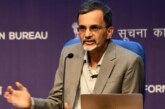By Shweta Tyagi, Executive Secretary, India Water Foundation
 The north Indian states of Haryana, Punjab and western uttar Pradesh, based on their genetic values, are the heartlands
The north Indian states of Haryana, Punjab and western uttar Pradesh, based on their genetic values, are the heartlands
of the world famous “Basmati Rice” growing areas and contribute more than 70% food grain to the central pool of India. These states are endowed with ample surface and groundwater resources and an appropriate climate for Basmati variety of rice production viz., high atmospheric humidity during vegetative growth, cooler nights during flowering period, and short days during crop maturity infusing aroma and good cooking quality. Ironically, these
states are facing crisis of water shortage owing to excessive withdrawals of the groundwater and excessive application
of water to rice crop. The depleting groundwater resource has been simply a matter of debate as not much has been done in action. A ‘Water Saving Consortium’ formed by Dunar Foods limited and International Finance Corporation took up this challenge. Ms. ShwetaTyagi, Executive Secretary, India Water Foundation at New Delhi provides a brief of the Consortium’s initiative in promoting water saving technology among farmers leading to sustainable farming and rice production in particular.
Conventionally for rice /paddy cultivation in Haryana and Punjab 17000 to 20,000 cubic meters per ha of irrigation water is used during crops growing period of 130-140 days. This involves growing nursery, field preparation, flooding and puddling of fields for making it fit for transplantation. Farmers are inclined to grow rice as they find it remunerative due to Government’s policy of providing reasonable minimum support price (MSP) for dwarf varieties and private buyers in bulk for Basmati varieties are available as there are a large no. of processing units this region has. So also, due to non-availability of assured marketing and similar support price cap for other crops like oilseeds and pulses, farmers are not implementing the diversification towards cropping pattern.
This challenge was taken up by Dunar Foods Limited1in collaboration with International Finance Corporation (IFC) by promoting improved water management technology and tools among farmers belonging to three districts of Karnal, Kaithal and kurukshetra through a ‘Water Saving Consortium’. The consortium provided facility of Laser Land Leveler (Figure 1),Dry Rice Seeders (Figure 2), and Turbo Happy (no till) Seeders (Figure 3) to Agriculture Technology Service Providers (ATSP) in the villages so that farmers could easily use them on custom hire basis. Farmers are being motivated through travelling seminars and latest spot practices to adopt water saving technologies which is the need of the hour.
This challenge was taken up by Dunar Foods Limited1in collaboration with International Finance Corporation (IFC) by promoting improved water management technology and tools among farmers belonging to three districts of Karnal, Kaithal and kurukshetra through a ‘Water Saving Consortium’. The consortium provided facility of Laser Land Leveler (Figure 1),Dry Rice Seeders (Figure 2), and Turbo Happy (no till) Seeders (Figure 3) to Agriculture Technology Service Providers (ATSP) in the villages so that farmers could easily use them on custom hire basis. Farmers are being motivated through travelling seminars and latest spot practices to adopt water saving technologies which is the need of the hour.
The 13thFinance Commission of the Government of India has made it obligatory for states to set up Groundwater Regulatory Authority, but the decision is yet to be implemented in to action as it needs very strong will power. The authority is expected to regulate and determine surface and groundwater and also decide about its entitlements amongst stakeholders in agriculture, industry, and domestic users. Customarily, it is taken for granted that the groundwater beneath the land is one’s own property and the land owner can pump out as much water as possible without any restrictions. The wealthy farmers are deepening their tube wells in the quest of extracting water from the common aquifer by depriving poor farmers. In this race the small farmers are the losers for sure who are compelled to take out water from deep aquifers although there requirement is negligible as compared to big farmers thus, forced to lease out or sell their land to big farmers. This is one reason that why small farmers are on the decrease in Punjab and Haryana, a trend which is contrary to other states in the country. There is a need to change this mind set through continuous dialogue, dissemination of knowledge and proper regulation. Measures like appropriate charging of electricity and restriction on digging of new wells need to be implemented urgently otherwise the land responsible for bringing green revolution and capable of feeding billion of mouths will turn into a rain. India will need 37% more rice and wheat by 2025 and agriculture water requirement s are expected to increase by 30%whereas it is estimated that around 9-10% less water availability. This will certainly increase tensions between different users and nations.
Dunar-IFC water saving project has been able to instill an appropriate amount of confidence in the farmers to adopt latest water saving technology, integrated pest and nutrients management of soil and shun old water guzzling practices which are very essential for sustainable farming and growth said Mr. Narender Singh, Executive Director, who is responsible for spearheading the campaign in a befitting manner in view of the crises in sight.



